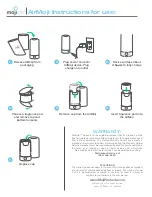
4
9. Start the washer.
Close the washer lid and pull out the cycle selector knob. The washer will not
agitate or spin with the lid open.
•
To stop the washer, push in the cycle selector knob.
•
To change a cycle, push in the cycle selector knob. Turn it clockwise to the
desired setting. Pull out the knob to restart the washer.
10. Remove items when the cycle is completed.
For your safety, the lid locks when the tub is spinning. It will remain locked for about
1 minute after the tub stops spinning.
•
To open the lid during a spin, push in the cycle selector knob and wait about
1 minute for the lid lock to release. Do not force open the locked lid.
Place washed items in automatic dryer, line dry, or dry flat as directed by fabric
care label. Excess wrinkling, color transfer or odors may develop in items left in the
washer after the cycle has ended.
To avoid serious personal injury, do not operate washer if safety lid lock
is missing or damaged.
6. Add laundry load to washer.
•
Dry load level should not be higher than top row of holes in wash tub.
Do not overload washer.
•
Do not put items on top of agitator or wrap them around it. Load items evenly.
•
Combine large and small items in a load. Load large items first. Large items
should not be more than half the total wash load.
•
When washing a single heavy item, add 1 or 2 towels to balance the load.
7. If desired, add liquid fabric softener to Fabric Softener
Dispenser
(some models).
For models with a built-in dispenser (see picture to the left):
1.
Add liquid softener to the dispenser, following fabric softener label directions.
2.
Add water to bring liquid level to fill line on dispenser cap.
3.
Remove the dispenser from the agitator after each use. Rinse both cap and cup
with warm water. Replace dispenser in the agitator.
NOTE:
To separate cap from cup, put thumb into dispenser and push against side
of cup (see picture to the left). After cleaning, push cap and cup firmly together.
Replace dispenser by lining up the ribs and grooves and snapping it into position.
Fabric softener will be flushed from area under the built-in fabric softener dispenser
when Large Load Water Level is selected. If a build-up of fabric softener occurs,
clean with hot water.
DO NOT REMOVE SERVICE CAP.
For models with a removable dispenser (see picture below to the left):
1.
Attach fabric softener dispenser to top of agitator by pressing down gently.
2.
Add softener to the dispenser, following fabric softener label directions.
3.
Add water to bring liquid level to top of the peg in the center of the cup.
4.
Remove the dispenser from the agitator after each use. Rinse both lid and bowl
thoroughly with warm water. Reassemble and place dispenser on agitator or
store it nearby.
For models without a fabric softener dispenser,
follow fabric softener label
directions. Add diluted fabric softener to the final rinse.
Do not pour fabric
softener directly on the wash load.
8. Set cycle selector knob and washer controls according to type,
size, and soil level of each load, and detergent used.
See
Operating Instructions
for your specific model controls.
Washing Procedures
(continued)
Removable Fabric Softener Dispenser
(some models)
Do not load items above
top row of holes in wash tub.
Built-In Fabric Softener Dispenser
(some models)
Built-In Fabric Softener Dispenser
(some models)































